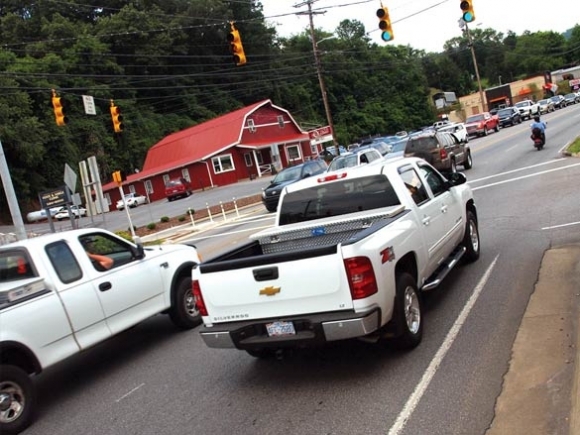Transportation plan for Jackson nears completion

After more than two years of meetings and mapping and analysis, the comprehensive transportation plan intended to guide Jackson County through the year 2040 will be sent on for regional and state approval if county commissioners give it the green light at their Aug. 28 meeting.
The plan analyzes where shortcomings in the county’s various transportation systems will likely arise over the next 25 years, making recommendations from road widening to bicycle lane construction to greenway development in order to address them.
“What this document helps us do is to give us a jumping-off point for identifying projects by putting them into one planning document that helps us as we start to move through the next stage of transportation development,” explained Mike Poston, the county’s planning director.
With the comprehensive plan in hand, county leaders will be able to more easily assess what projects need doing and from there search for funding to bring them to fruition. The comprehensive plan itself does not prioritize projects or guarantee funding.
Of the bigger projects recommended in the plan, at least one won’t be a surprise to Jackson County residents. The widening of N.C. 107 to a four-lane boulevard from U.S. 23 Business to just east of Fairview Road — the project also includes upgrading U.S. 23 Business to Skyland Drive — has already been identified as a priority project by the N.C. Department of Transportation and is slated for construction between fiscal years 2021 and 2023.
Other project concepts, meanwhile, are closer to their infancy. The plan recommends widening U.S. 441 to a four-lane boulevard in the Qualla area, from U.S. 74 to Casino Trail, a recommendation due not to a lack in road capacity but to the proliferation of businesses — and driveways — along the way. This disrupts the flow of traffic, creating an issue that the plan hopes to address.
Related Items
The plan would also bring improvements to U.S. 64 and N.C. 107 on their way through the Village of Cashiers, as well as new roads connecting the two routes in the northeast and southeast areas of Cashiers. However, the exact nature of those improvements is yet to be determined, Poston said.
“Sometimes we in the recommendations don’t know exactly what the exact solution is because we hadn’t had it studied yet,” Poston said. “We know there’s a problem but we don’t know what the best type of project would be until we start going through the project evaluation. This is kind of the kickoff to that whole discussion.”
The plan calls for widening projects on a host of smaller roads as well, in many cases asking that bike lanes and sidewalks be added at the same time. Monteith Gap and Ledbetter roads in Cullowhee both fall into that category. The draft plan had recommended a new extension connecting the roads in an attempt to alleviate pressure from increased student housing on Ledbetter, but that recommendation is no longer in effect following public comment that the DOT would do better to first focus on improving bicycle and pedestrian infrastructure on the existing roadway.
Additionally, the plan sets its sights on extending the existing mile-long Jackson County Greenway in Cullowhee north to Dillsboro. Multi-use paths should also be built to Scotts Creek Elementary School, Cullowhee Valley School Summit Charter School, Blue Ridge School, and the High Hampton community, the plan says.
Public transportation is also considered. A new transit route should connect Dillsboro, Webster, Forest Hills and Cullowhee, the plan says, with another route serving Cashiers.
Most of the funding for any recommended projects would come from the State Transportation Improvement Program, which awards dollars following a prioritization process in which the most-needed projects are identified locally and then sent on to the region and finally the state for prioritization of need and funding. However, the state legislature can also approve special allocations for transportation projects, so some money could come from that pot.
One needed project was not recommended in the plan, and that’s increased capacity on Mill and Main streets through Sylva into Dillsboro. The streets are approaching their capacity of 10,100 vehicles per day and expected to exceed that capacity by 2040.
“Neither town wants to impact businesses by widening the facility,” the plan reads. “It is also desirable to keep the on-street parking on Main Street and Mill Street in Sylva.”
There are some potential solutions to improve traffic flow without impeding parking, and while the plan suggests they’re worth the town’s consideration, none would fully address capacity deficiencies.
All four Jackson County municipalities have thus far approved the transportation plan, and its last stop locally is the Jackson County Board of Commissioners. The plan will then need approval from the Rural Planning Organization and N.C. Board of Transportation before taking effect. Commissioners will vote on whether to adopt the plan during a meeting at 6 p.m. Monday, Aug. 28, in the Jackson County Justice and Administration Building. Adoption does not require a public hearing, but all commissioner meetings allow opportunity for public comment at the start of the meeting.
The draft plan is online at www.planning.jacksonnc.org/pdfs/2017-jackson-county-comprehensive-transportation-plan.pdf.









